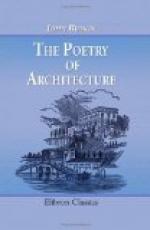30. The next striking point is the arcade at the base of the building. This is general in cities; and, although frequently wanting to the cottage, is present often enough to render it an important feature. In fact, the Italian cottage is usually found in groups. Isolated buildings are rare; and the arcade affords an agreeable, if not necessary, shade, in passing from one building to another. It is a still more unfailing feature of the Swiss city, where it is useful in deep snow. But the supports of the arches in Switzerland are generally square masses of wall, varying in size, separating the arches by irregular intervals, and sustained by broad and massy buttresses; while in Italy, the arches generally rest on legitimate columns, varying in height from one and a half to four diameters, with huge capitals, not unfrequently rich in detail. These give great gracefulness to the buildings in groups: they will be spoken of more at large when we are treating of arrangement and situation.
[Illustration: Italian Cottage Gallery, 1846. Chimney at Neuchatel; Dent du Midi and Mont Blanc in the distance.]
[Illustration: Cottage near la Cite, Val d’Aosta, 1838.]
31. The square tower, rising over the roof of the farther cottage, will not escape observation. It has been allowed to remain, not because such elevated buildings ever belong to mere cottages, but, first, that the truth of the scene might not be destroyed;[3] and, secondly, because it is impossible, or nearly so, to obtain a group of buildings of any sort, in Italy, without one or more such objects rising behind them, beautifully contributing to destroy the monotony, and contrast with the horizontal lines of the flat roofs and square walls. We think it right, therefore, to give the cottage the relief and contrast which, in reality, it possessed, even though we are at present speaking of it in the abstract.




